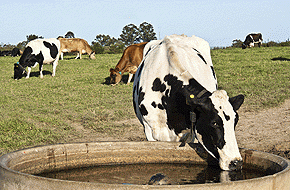
By Rodney Dickens*
 There is nothing new about the current high dairy export prices in that the current levels are similar to earlier peak levels in 2007/08 and 2010/11.
There is nothing new about the current high dairy export prices in that the current levels are similar to earlier peak levels in 2007/08 and 2010/11.
The left chart below shows the ANZ dairy commodity price indices measured in NZD terms and world price terms.
The much higher world prices than NZD prices in recent years reflect the negative impact of the high NZD.
In world price terms current prices are well above the levels that existed prior to 2007, with this related to a large extent to increased Chinese demand that was revealed in a Raving that looked at the massive impact China is having on a wide range of NZ commodity exports and tourism. Based on the 7 January Fonterra auction results, dairy product prices in USD terms remained high (right chart).
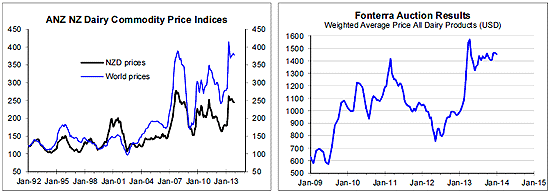
The surge in dairy product prices last summer shown in the charts above coincided with a serious drought that had a major negative impact on milk production, as shown in the left chart below.
In the first half of last year milk production fell 20% on a seasonally adjusted basis.
Lots of rain and great grass growing conditions resulted in milk production rebounding to peak levels over the second half of last year, again on a seasonally adjusted basis.
For an explanation of why some data are adjusted for seasonal patterns and how to interpret seasonally adjusted data see here.
Part of what drove up dairy product prices in the first half of 2013 was the drought and fall in supply, so it was always going to be interesting to see what happened to prices when production rebounded.
The answer is now available, with prices remaining near peak levels despite the rebound in production.
This means growth in Chinese demand much more than the drought drove the increase in prices.
This isn't to say prices will remain high indefinitely or head higher; the increase in prices could turn out to be at least partly self-defeating for the reasons discussed below.
What is particularly noteworthy is that the high prices have coincided with high production levels, which isn't normally the case. The right chart below shows a proxy measure for dairy industry income that is calculated by combining the milk production data from the left chart below with the ANZ NZD dairy commodity price index shown in the left chart above.
In terms of dairy industry incomes the latest boom is something special and this will have a number of consequences.
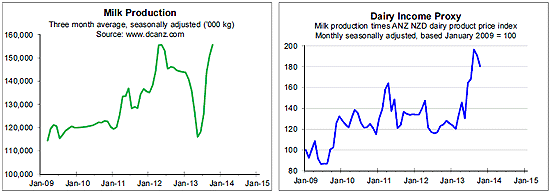
The pace of conversion to dairy farming should accelerate again
Local dairy farmers and farmers all around the world will respond to the high prices by increasing milk production via increasing herd numbers, aided in at least NZ's case by using more supplementary feeds like corn and maize, and by converting non-dairy farmland to dairying.
Converting non-dairy farmland to dairy farms and the associated building of milking sheds plays a significant part in driving the major cycles in farm building consents.
A rush of conversions to dairy farms in response to the surge in dairy product prices in 2007 was largely behind the high levels of farm building consents in 2008 shown in the left chart below.
The spike in farm building consents in October 2013 suggests that the latest surge in dairy export prices and incomes may have started to unleash another wave of dairy conversions.
It is normal for farm building consents to respond to changes in export prices with a lag, as shown in the right chart below. The black line shows the rolling annual average % change in the value of farm building consents. The red line shows the rolling annual average % change in the ANZ NZD dairy commodity price index with it advanced or shifted to the right by six months.
It isn't a perfect relationship, but in general around six months after an upturn/downturn in dairy commodity prices there has been an upturn/downturn in farm building consents.
Dairy commodity prices are better at explaining or predicting the behaviour of farm building consents than are overall export commodity prices, which reinforces the importance of dairy conversions in driving the major cycles in farm building consents.
Based on the surge in dairy product prices last year a solid upturn in farm building consents should be underway.
But with incomes also boosted by high production levels it is possible a mega-boom in dairy conversions will occur this year.
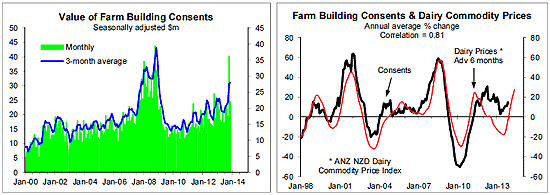
In NZ's case at least production per cow can be boosted by supplementing grass with corn kernels and maize. Driving around the Waipu District where we live it is noticeable how much more maize has been planted this year, with a local farmer saying the area planted is 30% higher than last year. I assume the same is happening in other districts, with it probably mainly driven by the high milk prices and partly a response to the drought last summer.
But price is a key consideration (i.e. if the milk price isn't high enough it isn't economic to use supplementary feeds).
The milk production numbers shown in the second chart above and more intensive feeding, although weather will continue to have short-term but significant impacts. More intensive feeding should allow farmers to run more cows per hectare, so upside in total milk production will be only partly reliant on dairy conversions. I only have access to milk production data back to 2009, as shown in the chart above that is reproduced below including a linear trend line calculated in excel (left chart below).
Setting aside the impact of droughts, a trend increase in dairy production appears to be underway.
This has been partly achieved on the land currently used for dairy farming via increased production per hectare and per cow. As discussed above, high milk prices mean supplementary feeds can be used to increase production per cow and the number of cows per hectare.
Innovation adds to this by improving herd genetics, grass genetics etc.
But a key driver of the trend increase in milk production is the outperformance of dairy product prices relative to prices for products that compete with dairying for land use.
The right chart below uses the ANZ NZD commodity price indices for dairy products, cattle and sheep products, forest products and horticultural products. The chart clearly shows dairy product prices outperforming other land-based product prices over the last decade with this being a key driver of land use (i.e. land use tends towards the usage that pays the highest returns, subject to some constraints discussed below).
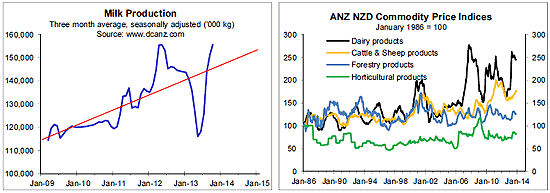
The conversion from sheep farming to dairying in Southland is a good example of this, as is the conversion from forestry to dairying in parts of the central North Island. People familiar with the drive between Taupo and Rotorua will have seen forestry being replaced by dairying.
Helping the switch to dairy is the fiasco of the carbon trading scheme.
The following is an excerpt from an article in the NZ Herald last year: "A survey of large forest owners (with over 10,000ha) by Professor Bruce Manley of Canterbury University has found they intend to deforest 39,000ha between now and 2020, mainly in the central North Island and mainly to switch to dairy farming."
Stock numbers tell a clear story with the left chart below showing that dairy cattle numbers have increased more than twofold since 1980 while sheep numbers have halved and beef cattle numbers have drifted lower (left hand scale for dairy and beef cattle numbers and right hand scale for sheep numbers, all in millions).
As an aside, deer numbers have fallen in the last decade but remain dramatically above 1980 levels, goat numbers have drifted down following the mega-boom/mega-bust cycle in the 1980s and pig numbers have drifted down since the 1970s (see the right chart below).
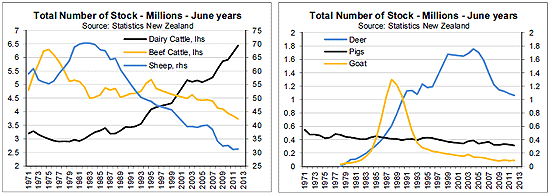
The super high dairy farm incomes should also give more impetus to irrigation schemes that can dramatically boost production and make dairy farming viable in areas it wasn't previously so.
Two large irrigation schemes are in the pipeline, although there may be other smaller ones. The largest is the Canterbury Central Plains Water's irrigation scheme where 60,000 hectares are planned for irrigation in three stages at a cost of $375m. 100 farms were reported to be in stage one where construction is expected to be completed by September 2015.
The second is the proposed Ruataniwha water storage dam in Hawke's Bay. The dam is expected to store enough water to irrigate 25,000 hectares and could also produce 6.5 megawatts of power, although it hasn't been confirmed when or if it will go ahead yet (see the second link below for more info).
The combination of growing Chinese demand for dairy products and NZ's ability to convert more land to dairying, suggest dairying will continue to grow in importance at the expense of other agricultural or horticultural land-users.
However, there are some constraints to what areas can be converted to dairying (e.g. rainfall, soil types, topography, and effluent and water quality issues).
Another possible constraint is the RBNZ's desire to breath down banks' necks scrutinising the level of farm debt.
A bi-product of more land being converted to dairying and Chinese demand for especially infant formula is the building of new dairy factories versus the continued struggle for the meat processing industry because of falling sheep and beef stock numbers.
Examples are the $214m factory in South Canterbury that will create 70 permanent jobs and the $220m infant formula plant at Pokeno south of Auckland that could create 100 jobs.
Dairying is also more labour intensive than sheep and beef farming, so more dairying means more housing for workers will be required in the relevant parts of the country.
So while it is partly a case of dairying usurping other agricultural and horticultural land users, there is a clear net gain in terms of national income, employment and economic activity.
The export volume numbers shown in the charts below tell a similar story to the stock numbers shown above, but with some interesting twists.
The export volume numbers are sourced from Statistics New Zealand and are measures in rolling annual thousands of tonnes of product exported. While sheep numbers have fallen hugely since the 1980s, the volume of mutton and lamb exports has cycled sideways rather than fallen (black line, left chart below).
I assume this reflects increased carcass weights and increased lambing percentages.
By contrast, wool exports have fallen significantly (blue line, right chart below).
Similarly, while beef cattle numbers have fallen significantly in the last 20 years the volume of beef and veal exports has cycled sideways rather than fallen (blue line, left chart). As an aside, fish and crustacean export volumes have cycled sideways (black line, right chart).
In terms of dairy exports, butter and more recently and more significantly milk powder have been the best performers (bottom two charts).
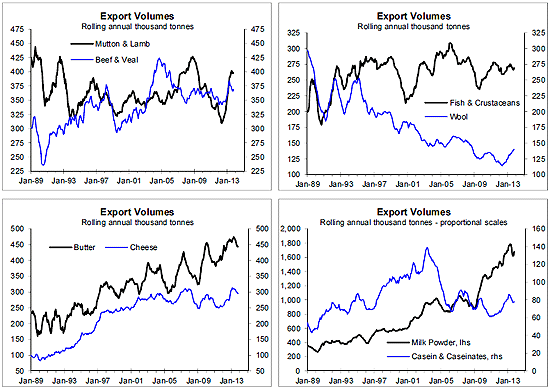
Some other implications and a potential left-field event
Whenever there is a boom there are always undesirable consequences or side-effects.
From a greenies perspective more dairy cows means more effluent and polluted waterways (dairy farming involving more cows per hectare than beef farming), with water quality a major national issue.
For the dairy industry a key consequence is that the boom will be partly self-defeating. The high prices will result in increased global production, while consumers around the world will respond to the high dairy product prices by cutting consumption.
The demand and supply responses to the latest surge in dairy product prices could mean the increase in prices is partly self-defeating (i.e. may result in lower demand and possibly lower prices at some stage).
But setting aside the tendency for the demand and supply behaviour to create significant short-term cycles in international dairy product prices, there is a major trend increase in Chinese consumption of dairy products that for some time should mean good demand if not also high prices.
The announcement that the one-child policy in China will be dropped has been heralded as a major positive for the NZ dairy industry although even without this boost to demand Chinese consumption of infant milk formula is expected to double by 2017 (see the first link below).
On the other hand, China is moving to increase productivity in the agricultural sector, which should mean increased dairy production.
But water is a major competitive advantage NZ has over China when it comes to dairy production, with this playing a part in driving Chinese investment in NZ dairy production facilities like the Pokeno plant, which some see as a challenge or negative implication (see the second link below).
However, if history has taught us anything it is that booms are never straight-line affairs.
There will be dark spots as well as bright spots along the way.
When we look back on it in 10-20 years it may well be viewed as a revolution more than an evolution, with NZ becoming a farm for China much as it was a farm for the UK in pre-European Union days.
But in addition to the dairy industry having entered a new era that will have a range of consequences, mostly good in terms of national wealth; developments in other industries and especially one could have a significant impact on it.
A left-field event or risk I regularly monitor and report on especially in our client Forex reports is the major oil and gas exploration programme underway in NZ this summer and that could continue for the next few years.
If major oil and gas finds are made they will turn the world upside down for many NZ exporters, including having a significant negative impact on dairy commodity prices in NZ dollar terms. Issues relevant to the NZ and US oil and gas industries have been covered in three previous Ravings (see here, here, and here).
And for non-dairy and non-petroleum exporters, if the white-gold and black-gold industries both fire up over the next several years the exchange rate will probably head to unfathomably painful heights that will offset part but not all of the benefits from the booms in these two industries.
------------------------------------------------------
*Rodney Dickens is the managing director and chief research officer of Strategic Risk Analysis Limited.
53 Comments
OK , Rodney.
Let us start off 2014 by making each new conversion absolutely (100%) responsible for its effluent and make illegal and punishable by shutdown any effluent that leaves that farm boundary.
How many conversions would there be?
None , zero zilch.
Then start on those from 2013 , 2012 etc Give them each 5 years to sort their mess.
Right a'hind you on the effluent thing there BB3 and I would like to chuck another few cents worth in.
I want to know how many of these farms would then end up in foreign hands.
I want to know why Rodney has neglected to mention PNK in the supplementary feed, how much of that will come from Sumatra where the govt is pretty much ensuring the demise of the Sumatran Orang Utan with the stroke of a pen. Oh it will look all legit, the new palm plantations and the dairy industry will give its halo a bit of adjustment and try to convince us they are obtaining this feed from "sustainable" sources - yeah right. It is time the use of palm products were exposed for their destructiveness, we are seeing rainforest disappear all over SE Asia, South America and Central Africa at a truly alarming rate, yet industries like dairying just bury their heads in the sand.
Land has now become too valuable, basically to grow crops on, does no-one else see something tragically wrong with that.
And water, yes water all those 70 litres required to produce 1 single litre of milk. Enough is now seriously enough, time for something else. You are going to need it to fall from the sky first and the Hawkes Bay is not the place for that, dam or no dam, it should not be being built for such a wasteful purpose as dairying
Get the foreign owner out of the market so that land prices can settle back down to a value where growing other things on it is viable again - as it should be!!
jeepers, you just made the ceo of ANZ spit his coffe out across his desk.
Its got to be option one, overseas control of our assets
He probably neglected to mention it because it is irrelevant. You do realise PKE is a byproduct? People don't plant oil palm for PKE - that would be the equivelent of sheep farming to make dags. Given oil palm is on a 25 year rotation (doesn't need annual replanting/cultivation) and is ten times more productive than oil seed rape/canola per ha it is a wonder crop. Not to mention lifting tens of millions of people out of poverty. People who now can afford to drink NZ milk and help us support our housing empire.
Sustainability... What is more sustainable a 25 year crop rotation or cultivating ten times the area annually in Europe to grow equivelent canola oil. If NZ doesn't buy this byproduct then Europe will.
70 itres of water to make of a litre of milk. Heard of the water cycle?
What's more sustainable? The rest of the world not demanding more of this stuff and facilitating the flattening of more rain forest, that's what and using PKE by product or not is just contributing to the whole thing
Do you know how hard it is these days to avoid product with Palm Oil in it. All these shower gels, shampoo, biscuits, bloody near everything. I try as hard as I can to avoid proucts with it, but boy does it restrict me, but that is my choice. There is only one or two brands of soap left now that use sodium tallowate as opposed to sodium palmate. It is about impossible with shampoos. I pretty much don't buy biscuits anymore, and check labels for vegetable oils (unspecified almost certainly mean palm oil), I have asked Fonterra if there are any milk products from cows not fed on PKE, they haven't replied
I don't want to use this stuff but I am often forced to. I refer to the Auckland Zoo "Buy Palm Oil Free" in an atempt to put my money where my mouth is
raegun - the 70litres of water per litre of milk is made up of what - green, blue or grey water? On farm use or including processing? Gross figure or net?
We use less than 7 litres of water (based on summer time use - it would be less if we averaged it out to take account of when the cows are away in the winter) including stock drinking water. Some of that is returned to the land as recycled water in the form of effluent irrigation and of course cows pee. We don't irrigate so only pump water for stock use and shed use.
What is the legal position at the moment as regards farm responsibility for effluent?
The consent holder holds legal responsibility for effluent. In our case that is our 50/50 sharemilker however in Southland farm staff (non consent holders) have also being prosecuted if they had a direct involvement in a spill. As a farm owner, even though we are not the consent holder we can be charged if we have failed to supply equipment/repairs etc to ensure a fully operational system.
Dairy, New Zealands Achilles tendon. Too much miss allocated debt, what a shame.
Hey guys if you don't live in the country have you ever wondered where your effluent goes?
Does it stay on your property?
Do the millions of litres of storm water fill of toxic acids oils and filth stay in your neighborhood?
Does the toxic gases produced from your motor vehicles stay in your air space? Most of it ends up in some one elses neighbor hood or out at sea polluting some ecosystem of plants and creatures.
What about your rubbish waste, if it doesnt end up in some toxic land fill some where it gets blown out to sea to strangle some rare species of mammal.
Yes Dairy has grown fast and yes it needs to take stock of its impact on its surroundings both good and bad.
But look in your back yard, you guys are far from squeaky clean.
What are you doing about it?????
Which is one reason why I do no think we should be "growing" our human population either
....and certainly not taking economic immigrants who have polluted their own countries way beyond what they find acceptable to live with. Genuine refugees I can accept in small numbers but allowing all and sundry to buy their way in is just adding to our future problems.
Right now Auckland wants to spend billions on more roads, water reticulation and considering PPPs (an expensive and failed concept in too many other countries) to do what the elected elite are incapable of managing.
Our effluent is tertiary treated and then sprayed onto plantation forest. How do you treat your herd's effluent?
I very much doubt our storm water has toxic acids or oils in measurable quantities. If it does then someone needs to be charged.
What toxic gases? Carbon monoxide and dioxide? They are toxic in large quantities but the greatest problem is particulates and of course the fact that CO2 is a greenhouse gas.
At least 80% of our waste is recycled.
You pay for the cost of your externalities / degradation of public goods and we will pay for ours. Sounds fair?
You pay for the cost of your externalities / degradation of public goods and we will pay for ours. Sounds fair?
Great one!
I wouldn't hold your breath for Zeebeck to engage - a strategic retreat is more likely. Pity.
I don't live in the country, but my waste stays on my property. Modern septic tank, glorified wormfarm.
I have taken responsibility.
Maybe, maybe not....
The extra greenfeed is all about this years $8.30.
Don't start us on the 10 cent dividend or the large funds filling up on units.....
Meanwhile the rush of conversions you talk will, we think, be of systems. To herd homes and the like.
Current farm values matched to existing farm systems are stuffed. With nitrate caps removing the blue sky.
See the ecan site (I am in the phone and fingers are fat).
Most farm deals are for taking a farm and changing its system/type. Steady state d farms of scale we don't see driving volume. The Overdale italians being the exception.
Not to worry folk move on and now need spend $2000 a cow or $20,000 per ha to realign to low nitrate. This expenditure gets valuations back to where they were re production potential.
Means everyone bau production is set higher. And all are process engineer. Some of the part/ex cropping guys do have a gift...
Take a look at the exporter over the past 6mths... and latest copy to see the dairy royalty who find it too expensive to supply fonterra.
We put on 3,000 kms round the SI last week or so. Its 50 shades of green. Lots of agent for sale signs. Just remember one with a red sold ribbon. Found the best whitebait sandwich in Westport...
Q: how do we think Fonterra's hedge is getting on?
Agree Henry.
Large funds filling up on units is interesting to watch. One day someone will ask 'Why?'
Our rivers are stuffed, and getting worse. The Parliamentary Commissioner for the Environment's report on water quality released late last year fingered the steady expansion of dairying as the culprit. The Commissioner covered the environmental issues in her report, but not the economic ones. In our view this scandal is New Zealand's version of the Global Financial Crisis (GFC), where profits of a few are leaving debts for generations to bear.
http://www.nzherald.co.nz/opinion/news/article.cfm?c_id=466&objectid=11…
Let's be clear up front; we aren't blaming the farmers. Like the bankers in the GFC they are just responding to the incentives the market presents them. And nowadays most farmers try to contain the environmental damage, many taking more remedial steps than they are required to. But just like the GFC, this is a massive failure of the regulatory regime. While rules around dairy conversions and intensification are emerging, they are simply inadequate to offset the rising environmental damage - unfortunately way too little and way too late to avert a crisis. Our lax taxation of the income earned on capital - a benefit that all landowners enjoy - also inflates the after-tax return to farming.
Well i suppose the farmers did the pollution, its logical they should be the ones paying to clean it up.
The shame is that after a payouts over the last 5 or 6 years, few have the retained profit to make the required capex implied without ringing the bank.
And folk on riverbed not the notional equity to give back to the bank facility when going to an extensive low cost system.
Question: could the OIO be thinking of nitrate bounded systems when thinking about the developers buying into Synlait F. As an aside some locals would prefer the new scheme water rights be excluded, or be divested upon a settlement of any deal.
Sometime in the future Dairy will not be the best use of the water. The problem associated with giving long term free water consents. Eventually regional councils will have to have the courage and the plan changes to charge for water.
Can you amplify what you mean by "long term free water consents": Does that imply farms using irrigation systems are getting their water "free" from the district councils?
Already could be there. Some of the dairy stars are saying, sod this grass its slowing me down, the land (usually not riverbed) can grow more and better DM with something other than grass.
Devils advocate Aj - how can Regional council charge for water when they don't own it nor own the infrastructure delivering it?
They charge for lots of things they don't own :-)
They charge for lots of things they don't own :-)
lol! So true! ;-)
The second is the proposed Ruataniwha water storage dam in Hawke's Bay. The dam is expected to store enough water to irrigate 25,000 hectares ...
Rodney, I think it is time to sharpen up your research. At the moment it appears to reflect National Party perception management of their economic policy. And the election is still 10 or 11 months away.
Sure, 25,000 ha could be irrigated at 1 in 2 year reliabiity of supply but only if the entire Makaroro catchment is by far the wettest of the Eastern Ruahines. It is not - instead being one of the driest.
Some EPA process evidence on the economics and water resource for the Ruataniwha scheme:
http://www.epa.govt.nz/resource-management/NSP000028/NSP000028_Hawkes_B…
http://www.epa.govt.nz/resource-management/NSP000028/NSP000028_Hawkes_B…
http://www.epa.govt.nz/resource-management/NSP000028/NSP000028_Hawkes_B…
The idea that only 'greenies' are concerned with the degradation of water quality due to dairy farming is downright wrong. It is a major concern for many New Zealanders and the Government and the farming industry ignore it at their peril.
"I very much doubt our storm water has toxic acids or oils in measurable quantities. If it does then someone needs to be charged."
Let's have a leetle fun with this bold statement.
City stormwater will have:
- asbestos dust from vehicle brakes )confirmed by our local Medical Officer of Health)
- rubber and plastics from vehicle tyres
- lighter-than-water rubbish (I regularly pick up from our local beach: 1/3 jetsam off boats, 1/3 careless beachwalkers, 1/3 flushed down the drains and rivers straight out to sea, then distributed up and down the coast)
- diesel and oil film, especially after rain
Pot, meet Kettle.
Absolutely nd again my argument for no further human population increase, a decrease on a worldwide basis
Forget worldwide and lets just concentrate on solutions for NZ by New Zealanders.
From a greenies perspective more dairy cows means more effluent and polluted waterways (dairy farming involving more cows per hectare than beef farming), with water quality a major national issue.
Replace the word greenies with general public and you will be closer to the mark.
No because the general public realise that we all have an impact on the environment in everything we do and know they should sort out their own backyard before pointing the finger at others and that the industry is constantly striving to improve the way they do things. The genral public also realise the benefit that billions of dollars of export revenue and jobs does for this country especially when so many other countries are still struglling since the GFC .
We all have an impact but the question is one of magnitude. Higher stock numbers = more effluent. We have to draw a line and say that pollution above a certain level is unacceptable. I would suggest that that line has already been crossed in parts of Canterbury and the Waikato. Further intensification should not occur until the problem is remedied.
ha ha...it is my backyard silly! As for the benefits...yep sure...we need all this cash so we can buy more big tv's, take overseas holidays, get a bigger suv, bring in more migrants to share the cake and all that other 'stuff' which actually has no enduring value at all.
Visited Lake Opuha in South Canterbury on the weekend. Excellent recreational facility with great public access built on the back of farming interests. Caught 5 very healthy brown trout up to 4lbs. Watersking was superb and the kids were safely swimming. In my view a yardstick on the successful collaboration of business, recreational and environmental interests. The key to a quality NZ future is adjusting our world view, we can start by expanding our context and ensuring equal growth in resources per capita, no matter our resource persuasion. By not collaborating, we will end up with win-loss situations and concentration of resources to particular interests, whether business, recreational or environmental. Maybe our Resource Management Act does not need an overhaul, instead a change in user context.
I presume you were trolling?
Lots of trolling on Lake Dunstan on the weekend Colin. Mixed bag of results. Bit like this site really. ;-)
True.
howsoever staying closer to HQ
http://nzfishing.com/FishingWaters/NorthCanterbury/NCFishingWaters/NCCl…
As kids we were often to be found paddling round Irwell/Leeston/Southbridge at new year.
https://www.facebook.com/SelwynDistrictCouncil/posts/172142016209416
and now
- Anna Clare can we let kids swim at coes ford over jan holidays? November 27, 2013 at 5:31pm
- Hamish Middleton Check the Ecan site for water quality. The 'temporary' health warning sign has now been there for many years so you can bet the chances of ever swimming at Coes Ford again as very very low. However lovely aquatic centres have been built in Lincoln and Rolleston to pacify those who believe it is their right to swim outdoors in unpolluted waterways. November 27, 2013 at 6:38pm via mobile
- Sarah Lewis Ever thought of running for council Hamish? November 27, 2013 at 6:50pm via mobile · 2
- Selwyn District Council Hi, looking at the ECAN maps online (http://maps.ecan.govt.nz/WaterQuality/), Coe's Ford is not suitable for swimming, however Chamberlains Ford water quality is good which is suitable for swimming most of the time so you may want to swim there (see explanation here: http://ecan.govt.nz/.../swimming-water-quality-grades...). November 27, 2013 at 7:30pm http://maps.ecan.govt.nz/WaterQuality/ Selwyn River at Coes Ford is Poor This grade is based on risk of faecal contamination and water testing for faecal indicator bacteria.
Lake Opuha at Ewarts Corner boat ramp is Fair
Lake Opuha at Recreation Reserve is Good
Lots of restrictions on irrigation
.
Indeed, though a range of methods will produce results. Preference is flyfishing, though trolling is the easiest in keeping my kids interested :>
Ours group on a minecraft server with real world mates keeping a running audio channel going using skype.
Hours of fun, with a squawkbox into half a doz kitchens.
Yeah, my son has a vanilla 1.7.4 server running I set up for him and his mates. They did have a voltz server which is a mod with power armour, nukes and anti-matter bombs...way fun.....lots of craters....I ended up hiding deep down under a lava lake......the buggers all ganged up on me....LOL
Its really neat for the architecture mind, they make some stunning buildings.
regards
What do overseas tourists think of part of a beach at Frankton (Queenstown) being closed due to sewage overflow - caused by reckless regard by urban population. http://www.odt.co.nz/news/queenstown-lakes/288202/care-urged-after-sewage-overflow
By the time the cause was publicised the tourists would have long gone. I suggest this would have left a longer impression on them than anything to do with dairy, especially since this was the third incident in the last two months. 'http://www.odt.co.nz/news/queenstown-lakes/288202/care-urged-after-sewage-overflow
Hawea has had an issue with e-coli this summer - could it be from their treated effluent that is sprayed on to farmland but unfit for human contact* causing contamination in times of heavy rain, like we had had at this time? http://haweacommunity.co.nz/uncategorized/queenstown-lakes-district-council-advises-that-hawea-residents-need-no-longer-boil-their-drinking-water/
*''It's treated effluent but it still has lots of bugs in it - pathogens - and it's not suitable for human contact." http://www.odt.co.nz/news/queenstown-lakes/237796/effluent-trial-begin
Swimmers are being advised to avoid Auckland's Mission Bay following concerns about poor water quality. January 09, 2014
http://tvnz.co.nz/national-news/mission-bay-closed-due-water-quality-co…
and
http://www.nzherald.co.nz/nz/news/article.cfm?c_id=1&objectid=11184331
The results could have been caused by a range of things, including a dead animal's carcass floating by, waste from boats and also a false-negative result.
re Mission Bay - Had visitors from UK over for Christmas. Considering moving to Auckland. Was told by Auckland family that beaches south of bridge around city 'are crap - go over bridge if you want good beaches'. Visitors thought they were speaking figuratively. ;-) Certainly created a negative impression.
So you think we should give up and accept pollution as part of life.
Perhaps we could them to spend 10% of their holiday helping clean up.
Based on the way the TPP is going, you had better start accepting that- not so much the headline news from the latest set of leaks, but that as a fundamental part of the treaty offshore companies will be able to take the government to the deciding offshore tribunal if the government passes environmental law that hurts the companies profits. So a tax on international visitors would be unable to be passed under the treaty.

We welcome your comments below. If you are not already registered, please register to comment
Remember we welcome robust, respectful and insightful debate. We don't welcome abusive or defamatory comments and will de-register those repeatedly making such comments. Our current comment policy is here.